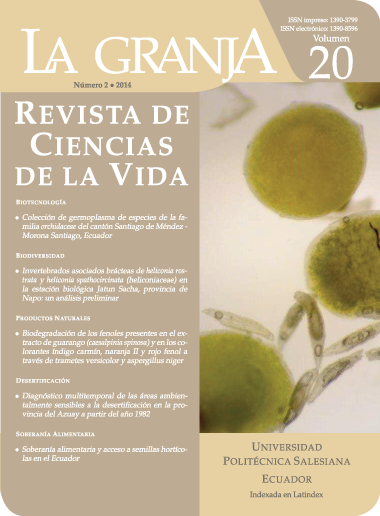GUARANGO EXTRACT (Caesalpinia Spinosa) AND INDIGO CARMINE, ORANGE II, AND RED DYES PHENOL BIODEGRADATION THROUGH Trametes Versicolor AND Aspergillus Niger
Main Article Content
Abstract
This research was done to evaluate phenol biodegradation capacity in Guarango (Caesalpinia spinosa) tannic extract phenols and in indigo carmine, orange II and red phenols, common residues in the textile industry. Two types of fungi were used, white-rot Trametes versicolor fungus and the filamentous Aspergillus niger. Biological treatments were applied in triplicate through the spectrophotometric UV method for 15 days. When applying the Trametes versicolor fungus to the tannic extract, there was 69.45 % degradation, and a 100 % discoloration in the indigo carmine. When applying the Aspergillus niger fungus to the tannic extract and orange II dye, there was a 63,45 % and 32,78 % degradation, respectively. There was a discoloration no greater than 26 % when applying Trametes versicolor and Aspergillus niger to the red phenol. The fungi applied during the biological treatment presented tolerance to both the tannic extract composition as well as the concentration of each dye used, verified through growing kinetics of each fungus.
Article Details
Section
Scientific Article
Universidad Politécnica Salesiana of Ecuador preserves the copyrights of the published works and will favor the reuse of the works. The works are published in the electronic edition of the journal under a Creative Commons Attribution/Noncommercial-No Derivative Works 3.0 Ecuador license: works can be copied, used, disseminated, transmitted and publicly displayed.
The undersigned author partially transfers the copyrights of this work to Universidad Politécnica Salesiana of Ecuador for the printed edition.
References
Garzón, R. 2009. Cinética de degradación de colorantes textiles de diferentes clases químicas por hongos y bacterias inmovilizados sobre fibra de Agave tequilano Webber var. Azul. Bogotá, págs. 4–5.
Marín, I., J. Sanz y R. Amils. 2005. Biotecnología y medioambiente. Editorial Ephemera, Madrid, España, págs. 60, 63.
Miranda, M. y A. Cuéllar. 2001. Farmacognosia y Productos Naturales. Editorial “Félix Varela”, La Habana, Cuba.
Moreno, N. y X. Ospina. 2008. Evaluación de inductores metálicos y co-sustratos para la remoción de negro 5 empleando Pleurotus ostreatus inmovilizado en fique. Pontificia Universidad Javeriana.
Rajchenberg, M. 1996. Los hongos pudridores de nothofagus pumilio (lenga): identificación de cultivos puros. Universidad Austral de Chile, 17: 97–98.
Robinson, T., G. McMullan, R. Marchant y N. P. 2001. Remediation of dyes in textile effluent: a critical review on current treatment technologies with a proposed alternative. Bioresource Technology, págs. 77, 247–255.
Rodríguez, R. y C. Aguilar. 2009. Biodegradación de taninos. Universidad Autónoma de Coahuila, URL ?http://www.postgradoeinvestigacion. uadec.mx/CienciaCierta/CC17/cc17taninos. html?, obtenido el 11 de Enero de 2011.
Marín, I., J. Sanz y R. Amils. 2005. Biotecnología y medioambiente. Editorial Ephemera, Madrid, España, págs. 60, 63.
Miranda, M. y A. Cuéllar. 2001. Farmacognosia y Productos Naturales. Editorial “Félix Varela”, La Habana, Cuba.
Moreno, N. y X. Ospina. 2008. Evaluación de inductores metálicos y co-sustratos para la remoción de negro 5 empleando Pleurotus ostreatus inmovilizado en fique. Pontificia Universidad Javeriana.
Rajchenberg, M. 1996. Los hongos pudridores de nothofagus pumilio (lenga): identificación de cultivos puros. Universidad Austral de Chile, 17: 97–98.
Robinson, T., G. McMullan, R. Marchant y N. P. 2001. Remediation of dyes in textile effluent: a critical review on current treatment technologies with a proposed alternative. Bioresource Technology, págs. 77, 247–255.
Rodríguez, R. y C. Aguilar. 2009. Biodegradación de taninos. Universidad Autónoma de Coahuila, URL ?http://www.postgradoeinvestigacion. uadec.mx/CienciaCierta/CC17/cc17taninos. html?, obtenido el 11 de Enero de 2011.

